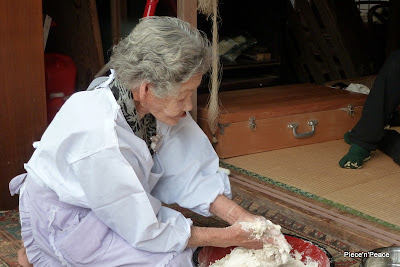Without going into too much unpleasant detail I also want to share an interesting result of my time in Japan. Some of you will know I have Crohn's (an inflammatory bowel disease). While I was in Fujino I had no urgent trips to the bathroom and no bowel pain. I can only attribute this to the Japanese diet as I certainly wasn't taking things easy or otherwise taking care of myself.
The diet we enjoyed was basic, healthy food. Whether we were eating at home or out in a range of lovely restaurants we ate a large percentage of vegetables to carbohydrate and protein, very little that was processed, refined or containing sugars and fats. As my DD said..."we all know this!!" Yes, we had a marvellous pizza made by Tohai (seen barbequing river fish below) one evening and we ate rather more mochi than is good for our hips and thighs but basically we ate a healthy Japanese diet and I felt very good on it. The fabulous Ogata-san, who came to make us udon noodles, regularly climbs the mountain to collect vegetables for her meals, she is 94.
I have ordered a couple of Japanese cookery books
Everyday Harumi and Japanese Cooking: A Simple Art
and will be incorporating such delights as seared tuna with mango and avocado salsa into my diet, I will also be drinking a lot more green tea (the proper leaves, not the dust in a bag from the supermarket. Bryan's landlord gave us all a bag of his tea and during the tour we were drinking green tea from Bryan's own tea fields, how wonderful is that?)
I will not attempt to identify all the foods in the photos below, suffice to say I tried everything (even the leaf that set my throat into spasm) and enjoyed most of it.
I am also wondering whether presentation and chopsticks are part of the health-giving Japanese diet effect. The ceramics and the arrangement of the food delight the eye and make it more than just something to prevent hunger. Using chopsticks slows down the eating process (certainly for me although I did improve tremendously) and helps us to savour each mouthful of food.
























my, you are a very adventurous eater! As a change from western servings, all in matching dinnerware, I like the variety of dishes, chosen to go with the thing served rather than the pottery from all the same kiln.
ReplyDeleteVery interesting to see how you get on when you change your diet hear.It sounds as if you had a real good time.
ReplyDeleteTricia
Oh, wanderful to see these pictures and feel the taste of food again! Our trip was really a full experience.
ReplyDeletethat's what i was thinking, as i read...so beautifully presented. it all looks so appealing. you are a much more adventurous eater than i would have been. glad you enjoyed it.
ReplyDeleteOh yum Lis. I can recognised one dish I made. It's wild mushroom spaghetti! I miss Japanese food. So glad you got yourself some recipe books. I must try to make some too - hugs Nat
ReplyDeleteThe whole trip must have been just sooo amazing!! Every aspect of life there firing at your senses from all directions. I'm sure you were nicely whacked at the end of each day and had good nights' sleep.
ReplyDeleteAs for the food suiting your condition, I've always thought that the wrong diet has a lot to do with many of the conditions we suffer from in the West!.
Teresa x
I came over from Nat and had a lovely time joining you on your adventures in Japan!
ReplyDeleteWow, I think that woud have daunted me without having your problems? I'm not very brave with food
ReplyDeleteI am glad to hear both you and your body enjoyed the Japanese cuisine. A lot of vegetable dishes are served in Japan and also the whole range of seaweed and various soy bean products. As can be seen from the pictures, food preparation is often done from scratch in the home and that takes a LOT of time. We pay with our health for the convenience of food processed in a factory and easily served at home (microwave meals, TV dinners, boil-in-the-bag....
ReplyDeleteI hope you will make use of Harumi Kurihara's cookery book; she has a good sense of taste and all her recepies are delicious.
Japanese cuisine is very low in raw milk products & milk derived dairy products generally - do you think that helps? I have a raw milk intolerance (missing enzyme, so I can't digest raw milk & cream), so food in Japan is great for me. Also there's foods like natto and other fermented probiotic veggie based things, like miso paste, that could be helping your digestion. Natto is a fantastic probiotic food, so long as you don't mind the stickiness and the strong taste (though not as strong as a lot of western foods). Enjoy cooking Japanese food!
ReplyDelete